Automotive Parts Die Casting Market Size
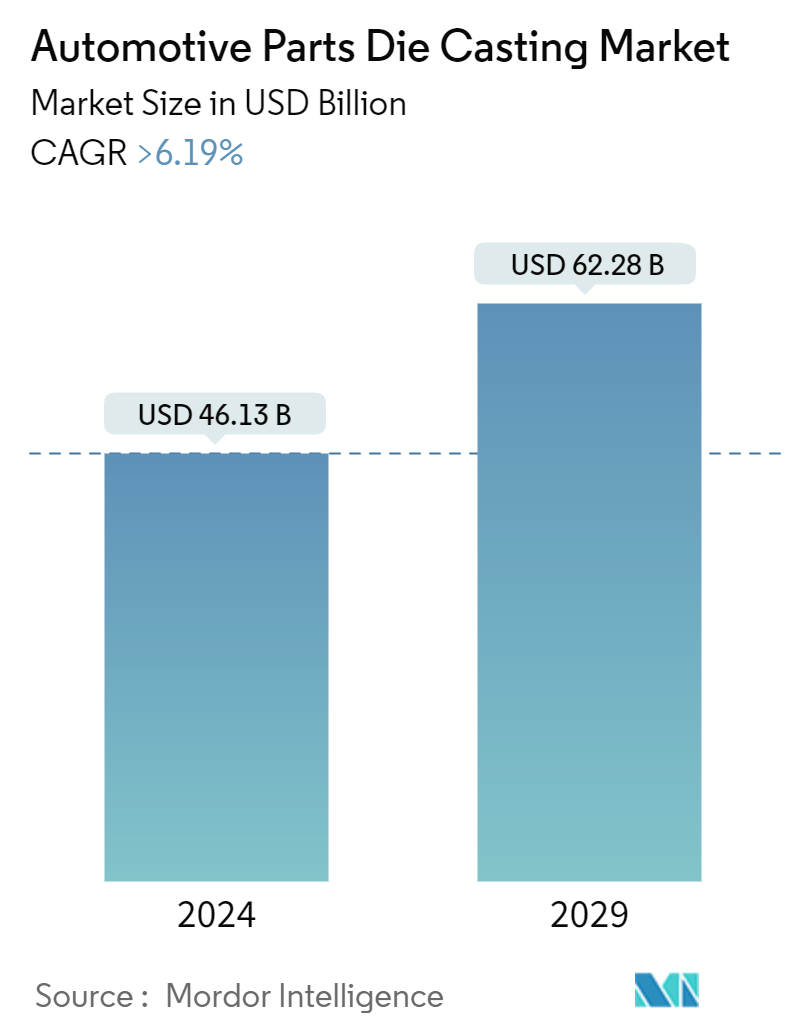
| Study Period | 2019 - 2029 |
| Market Size (2024) | USD 46.13 Billion |
| Market Size (2029) | USD 62.28 Billion |
| CAGR (2024 - 2029) | 6.19 % |
| Fastest Growing Market | Asia Pacific |
| Largest Market | North America |
Major Players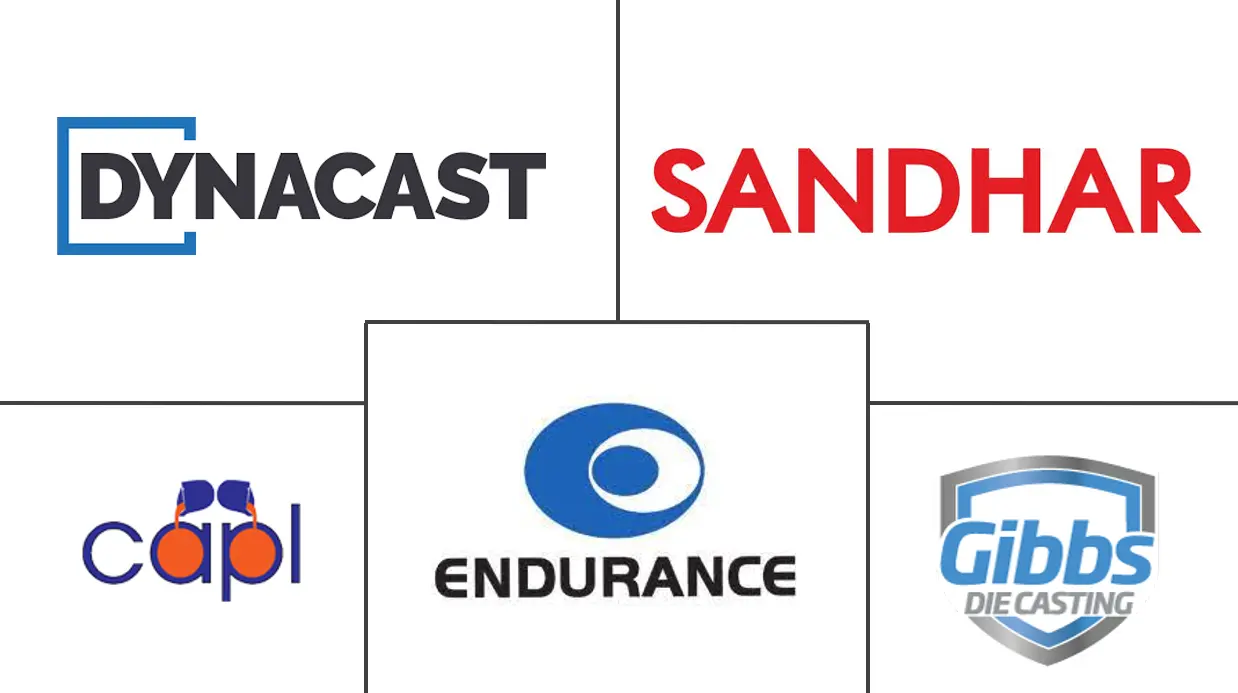
*Disclaimer: Major Players sorted in no particular order |
Automotive Parts Die Casting Market Analysis
The Automotive Parts Die Casting Market size is estimated at USD 46.13 billion in 2024, and is expected to reach USD 62.28 billion by 2029, growing at a CAGR of greater than 6.19% during the forecast period (2024-2029).
The automotive parts die casting market is experiencing significant growth, primarily driven by the global shift toward lightweight vehicles and the increasing popularity of electric vehicles. This trend toward lighter vehicles arises from the need to improve fuel efficiency and reduce carbon emissions, aligning with global environmental regulations and sustainability goals. Electric vehicles, in particular, require complex, high-precision components that are both lightweight and sturdy, and die casting is an ideal process to meet these demands.
For instance, CAFÉ standards and EPA policies to reduce automobile emissions and increase fuel efficiency are driving automobile manufacturers to reduce the weight of the automobile by using lightweight, non-ferrous metals. The move by the EPA to raise the miles per gallon (mpg) standards to 54.5 mpg by 2025 has helped the die casting industry, as the only way to get to those mileage standards is by manufacturing lightweight vehicles. Subsequently, using die cast parts as a weight-reduction strategy is a major driver for the market.
Further, advancements in die casting technology are significantly contributing to the expansion of the market. Innovations in machine design, process control, and mold technologies improve the efficiency and quality of die casting operations. These technological improvements increase the precision and strength of the cast parts and reduce waste and energy consumption, making the process more environmentally friendly and cost-effective. Integrating automation and digital technologies, such as computer-aided engineering (CAE) and the Internet of Things (IoT), optimizes the die casting process, leading to reduced lead times and increased productivity.
Moreover, the versatility of die casting allows for the production of a wide range of automotive parts, including intricate engine components, transmission systems, and structural elements. High-pressure die casting (HPDC) has emerged as a prominent technology, offering high-speed production capabilities and the ability to produce complex shapes with high dimensional accuracy. Moreover, vacuum die casting is gaining traction due to its ability to produce parts with superior mechanical properties and minimal porosity, further enhancing the quality and durability of automotive components.
As vehicle manufacturers increasingly focus on reducing vehicle weight to meet stringent emission standards and improve battery range in EVs, the demand for innovative die casting solutions is expected to surge. This is likely to lead to further advancements in materials and processes, such as the development of new alloys and enhanced casting techniques, to meet the evolving requirements of the automotive industry.
Automotive Parts Die Casting Market Trends
Pressure Die Casting Holds the Largest Market Share While Vacuum Die Casting is Expected to Witness a High Growth Rate
Pressure die casting is the largest category based on production type. Pressure die casting dominates the automotive parts die casting market with its efficient, high-volume, intricate, and durable components production.
Pressure die casting has been pivotal in the automotive parts die casting market, primarily due to its proficiency in fabricating high-volume, complex parts with perfect surface finish. Additionally, high-pressure die casting (HPDC) is increasingly used to produce large auto parts.
Major automotive companies like Tesla are utilizing HPDC to manufacture significant components, such as the front and rear ends of vehicles, as single parts. This application of HPDC has led to significant advancements in the efficiency and sustainability of automotive manufacturing processes. For instance, HPDC allows for replacing 70 to 100 parts with a single part, drastically reducing production complexity and improving overall efficiency.
While pressure die casting has the largest share, vacuum die casting is expected to emerge as the fastest-growing segment in the automotive parts die casting market, driven by its ability to enhance the quality and strength of manufactured components. This growth trajectory is underpinned by the technology’s intrinsic advantage in mitigating air entrapment during the casting process, thereby ensuring the production of components with enhanced structural integrity.
Further, vacuum die-casting significantly reduces porosity, creating denser and more robust automotive parts. This attribute is increasingly sought in producing critical automotive components, where superior quality and strength are non-negotiable. Moreover, the method’s proficiency in manufacturing high-quality, durable parts positions it as an indispensable technology in the evolving automotive manufacturing sector, particularly for components that require higher reliability and performance standards.
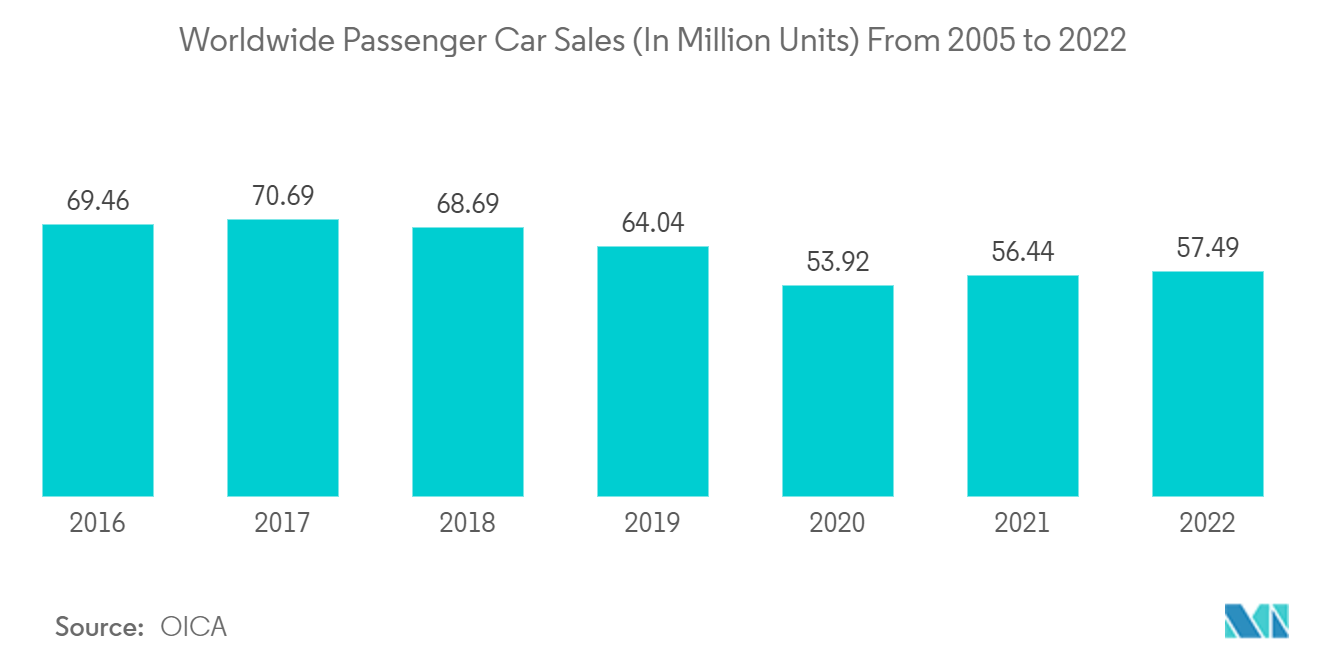
The Asia-Pacific Region is Expected to Play Key Role in the Market
The Asia-Pacific region is expected to play a dominant role in the market owing to the presence of key countries like India, China, and Japan. China is one of the major producers of die casting parts, accounting for more than 60% of the regional (Asia-Pacific) die casting market share.
The Asia-Pacific region leads in the automotive parts die casting market because of significant contributions from China and India. This is due to their growing car industry, high vehicle production, and major car manufacturers based there.
In 2022, over 35 million vehicles were produced in Asia-Pacific, with China accounting for 27 million motor vehicles alone. China was followed by Japan and India, which produced over 7.8 million and 5.4 million motor vehicles, respectively. Additionally, the overall commercial vehicle sales in the region in 2022 were registered at over 6.6 million units; over 3.3 million units were sold in China alone.
Moreover, the Asia-Pacific region derives strength from a well-entrenched manufacturing infrastructure, augmented by government policies favorably inclined toward the automotive industry's growth, thereby cementing its leadership position in the global context. Factors such as new manufacturing technologies and a focus on fuel-efficient cars shape the market.
The increasing wealth of the middle class also positively impacts the market growth. The region's push for advanced car technologies like electric and hybrid vehicles, backed by government policies for clean energy vehicles and environmental concerns, drives the market. This evolving market environment in Asia-Pacific, marked by rapid growth and technological advancements, is expected to drive the global automotive parts further die casting industry.
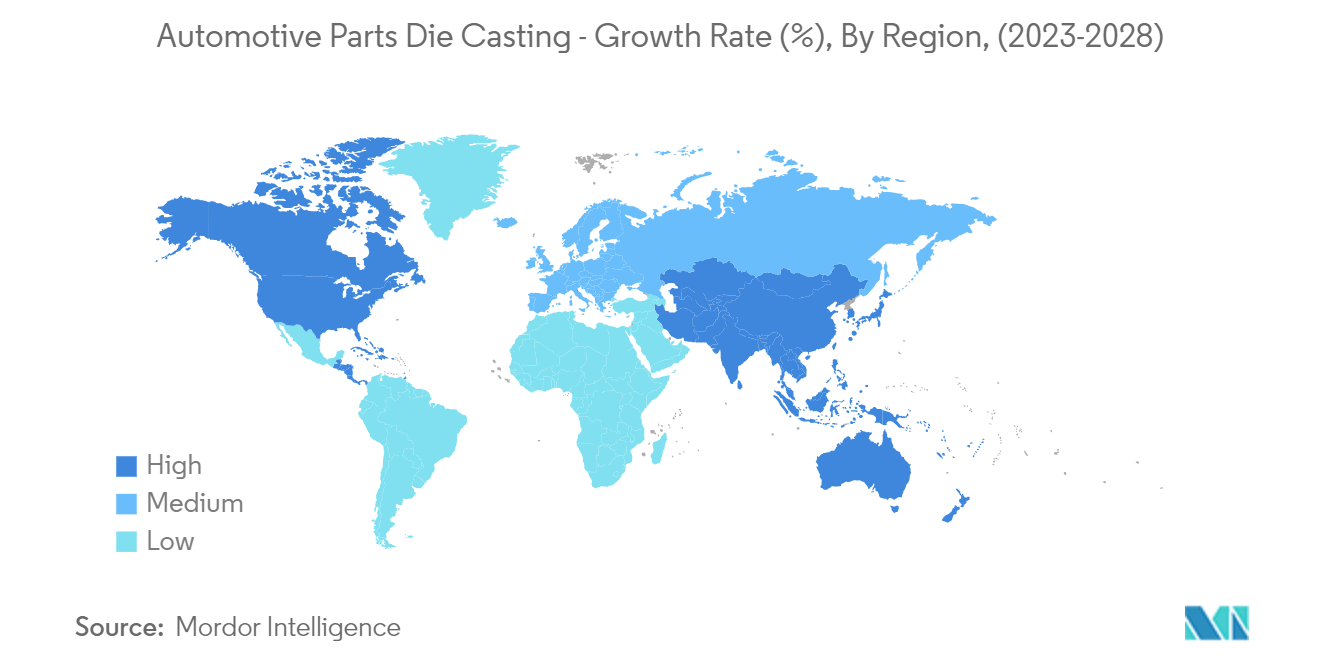
Automotive Parts Die Casting Industry Overview
The global market for die casting is fragmented, with many regional small-medium scale players from developing countries entering the market. Major recognized players, such as Nemak, Georg Fischer Automotive, Ryobi Die casting, Rheinmetall AG, Form Technologies Inc. (Dynacast), and Shiloh Industries, accounted for over 16% of the global market share. These key players have focused their revenues on R&D to develop better production processes and alloys for automotive parts. For instance,
- In October 2023, Kentucky Industrial Holdings Inc. purchased the Rane Precision Die Casting facility in Russellville, Kentucky. The plant specializes in aluminum castings for the automotive and other industries.
Automotive Parts Die Casting Market Leaders
-
Castwel Auto parts Pvt. Ltd
-
Dynacast
-
Endurance Group
-
Gibbs Die-casting Group
-
Sandhar Technologies Limited
*Disclaimer: Major Players sorted in no particular order
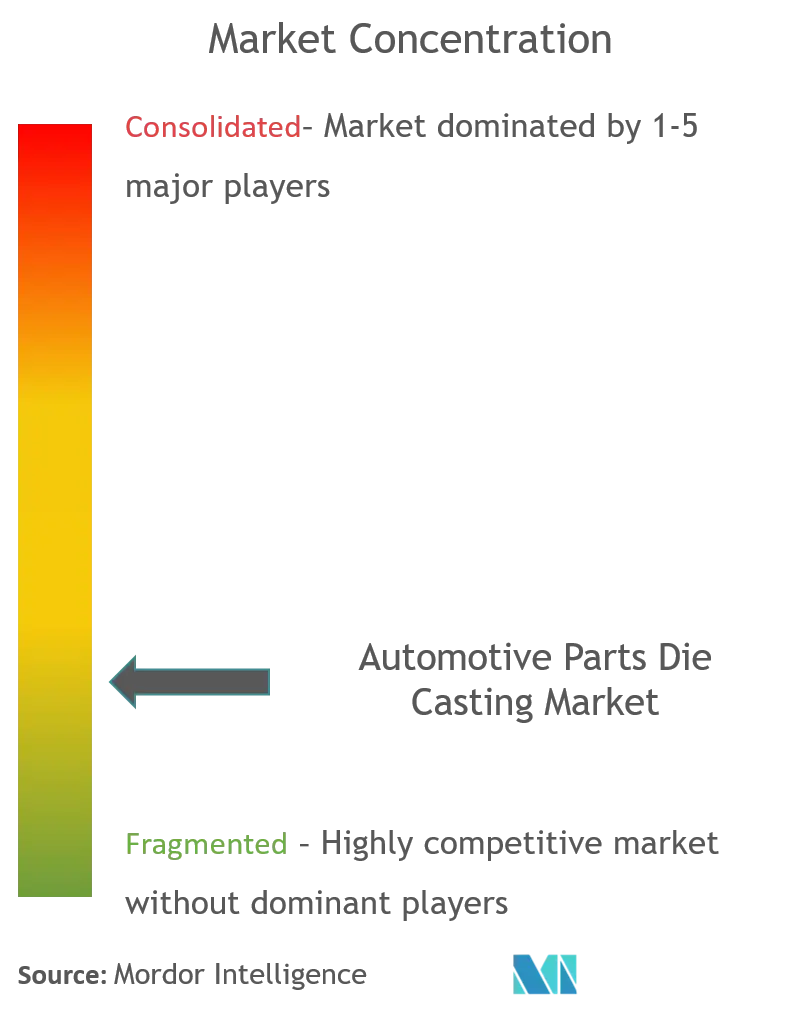
Automotive Parts Die Casting Market News
- November 2023: General Motors Corp. acquired Tooling & Equipment International, a Livonia, MI, developer and manufacturer of casting molds and tooling, as well as prototypes and low-volume production castings. GM will use Tooling & Equipment International's experience in designing molds and core boxes for high-volume manufacturing of automotive castings, including tooling for cylinder heads, cylinder blocks, drivelines, chassis, and suspension castings.
- November 2023: Linamar revealed that it will supply its products to the EV industry from its new Ontario-based gigacasting plant. Linamar’s facility will be the first gigacasting plant owned and operated by a North American parts maker.
- November 2023: IDRA Group was awarded a contract by Volvo Cars for two 9,000-ton giga press machines installed at the automaker's future electric vehicle factory in Košice, Slovakia. According to the company, the 9,000-ton aluminum casting machines, among Europe's largest die casting machines, represent a remarkable leap forward in automotive manufacturing technology.
Automotive Parts Die Casting Market Report - Table of Contents
1. INTRODUCTION
- 1.1 Study Assumptions
- 1.2 Scope of the Study
2. RESEARCH METHODOLOGY
3. EXECUTIVE SUMMARY
4. MARKET DYNAMICS
-
4.1 Market Drivers
- 4.1.1 Increasing Demand for High-Performance Vehicles Will Drive the Market
-
4.2 Market Restraints
- 4.2.1 Supply Chain Disruption of Raw Materials Could be a Challenge
- 4.2.2 High Initial Cost Related to the Purchase of Raw Materials is a Challenge
-
4.3 Porter's Five Forces Analysis
- 4.3.1 Threat of New Entrants
- 4.3.2 Bargaining Power of Buyers/Consumers
- 4.3.3 Bargaining Power of Suppliers
- 4.3.4 Threat of Substitute Products
- 4.3.5 Intensity of Competitive Rivalry
5. MARKET SEGMENTATION (Market Size in Value - USD Billion)
-
5.1 Production Process Type
- 5.1.1 Pressure Die Casting
- 5.1.2 Vacuum Die Casting
- 5.1.3 Squeeze Die Casting
- 5.1.4 Semi-solid Die Casting
-
5.2 Raw Material
- 5.2.1 Aluminum
- 5.2.2 Zinc
- 5.2.3 Magnesium
- 5.2.4 Other Raw Material Types
-
5.3 Application Type
- 5.3.1 Body Assemblies
- 5.3.2 Engine Parts
- 5.3.3 Transmission Parts
- 5.3.4 Other Application Types
-
5.4 Geography
- 5.4.1 North America
- 5.4.1.1 United States
- 5.4.1.2 Canada
- 5.4.1.3 Rest of North America
- 5.4.2 Europe
- 5.4.2.1 Germany
- 5.4.2.2 United Kingdom
- 5.4.2.3 France
- 5.4.2.4 Spain
- 5.4.2.5 Rest of Europe
- 5.4.3 Asia-Pacific
- 5.4.3.1 India
- 5.4.3.2 China
- 5.4.3.3 Japan
- 5.4.3.4 South Korea
- 5.4.3.5 Rest of Asia-Pacific
- 5.4.4 Latin America
- 5.4.4.1 Mexico
- 5.4.4.2 Brazil
- 5.4.4.3 Argentina
- 5.4.5 Middle East and Africa
- 5.4.5.1 United Arab Emirates
- 5.4.5.2 Saudi Arabia
- 5.4.5.3 Rest of Middle East and Africa
6. COMPETITIVE LANDSCAPE
- 6.1 Vendor Market Share
-
6.2 Company Profiles
- 6.2.1 Castwel Auto Parts Pvt Ltd
- 6.2.2 Die-casting Solutions GmbH
- 6.2.3 Dynacast International Inc.
- 6.2.4 Endurance Group
- 6.2.5 Gibbs Die-casting Group
- 6.2.6 Kinetic Die-casting Company
- 6.2.7 Mino Industry USA Inc.
- 6.2.8 Ningbo Parison Die-casting Co. Ltd
- 6.2.9 Raltor Metal Technik India Pvt. Ltd
- 6.2.10 Rockman Industries Ltd
- 6.2.11 Ryobi Die-casting Inc.
- 6.2.12 Sandhar Technologies Limited
- 6.2.13 Sipra Engineers Pvt. Ltd
- 6.2.14 Spark Minda, Ashok Minda Group
- 6.2.15 Sunbeam Auto Pvt Ltd
- 6.2.16 Texas Die-casting
- 6.2.17 Tyche Diecast Private Limited
- *List Not Exhaustive
7. MARKET OPPORTUNITIES AND FUTURE TRENDS
- 7.1 Increasing Inclination Towards the Use of Lightweight and Sustainable Materials Will be Key Trend
Automotive Parts Die Casting Industry Segmentation
Die casting is a metal casting process in which molten metal is forced into a mold cavity under high pressure. The machine used for that purpose is known as die casting.
The automotive die casting market is segmented by production, raw material, application, and geography. The market is segmented by production types, such as pressure die-casting, vacuum die-casting, squeeze die-casting, and semi-solid die-casting. By raw material type, the market is segmented as aluminum, zinc, magnesium, and other raw material types. The market is segmented by application type into body assemblies, engine parts, transmission parts, and other applications. The market is segmented by geography, such as North America, Europe, Asia-Pacific, Latin America, the Middle East, and Africa.
The report covers the market size and forecasts for the die-casting market for each segment in terms of value (USD).
| Production Process Type | Pressure Die Casting | |
| Vacuum Die Casting | ||
| Squeeze Die Casting | ||
| Semi-solid Die Casting | ||
| Raw Material | Aluminum | |
| Zinc | ||
| Magnesium | ||
| Other Raw Material Types | ||
| Application Type | Body Assemblies | |
| Engine Parts | ||
| Transmission Parts | ||
| Other Application Types | ||
| Geography | North America | United States |
| Canada | ||
| Rest of North America | ||
| Geography | Europe | Germany |
| United Kingdom | ||
| France | ||
| Spain | ||
| Rest of Europe | ||
| Geography | Asia-Pacific | India |
| China | ||
| Japan | ||
| South Korea | ||
| Rest of Asia-Pacific | ||
| Geography | Latin America | Mexico |
| Brazil | ||
| Argentina | ||
| Geography | Middle East and Africa | United Arab Emirates |
| Saudi Arabia | ||
| Rest of Middle East and Africa |
Automotive Parts Die Casting Market Research FAQs
How big is the Automotive Parts Die Casting Market?
The Automotive Parts Die Casting Market size is expected to reach USD 46.13 billion in 2024 and grow at a CAGR of greater than 6.19% to reach USD 62.28 billion by 2029.
What is the current Automotive Parts Die Casting Market size?
In 2024, the Automotive Parts Die Casting Market size is expected to reach USD 46.13 billion.
Who are the key players in Automotive Parts Die Casting Market?
Castwel Auto parts Pvt. Ltd, Dynacast, Endurance Group, Gibbs Die-casting Group and Sandhar Technologies Limited are the major companies operating in the Automotive Parts Die Casting Market.
Which is the fastest growing region in Automotive Parts Die Casting Market?
Asia Pacific is estimated to grow at the highest CAGR over the forecast period (2024-2029).
Which region has the biggest share in Automotive Parts Die Casting Market?
In 2024, the North America accounts for the largest market share in Automotive Parts Die Casting Market.
What years does this Automotive Parts Die Casting Market cover, and what was the market size in 2023?
In 2023, the Automotive Parts Die Casting Market size was estimated at USD 43.27 billion. The report covers the Automotive Parts Die Casting Market historical market size for years: 2019, 2020, 2021, 2022 and 2023. The report also forecasts the Automotive Parts Die Casting Market size for years: 2024, 2025, 2026, 2027, 2028 and 2029.
Automotive Parts Die Casting Industry Report
Statistics for the 2024 Automotive Parts Die Casting market share, size and revenue growth rate, created by Mordor Intelligence™ Industry Reports. Automotive Parts Die Casting analysis includes a market forecast outlook to 2029 and historical overview. Get a sample of this industry analysis as a free report PDF download.



